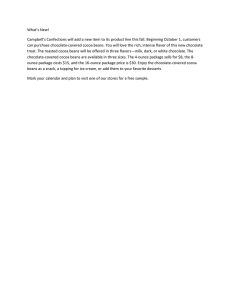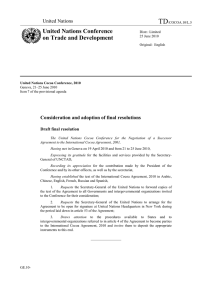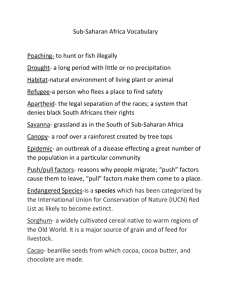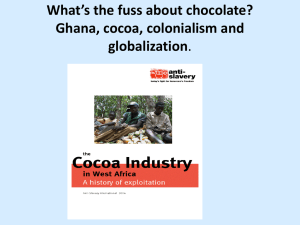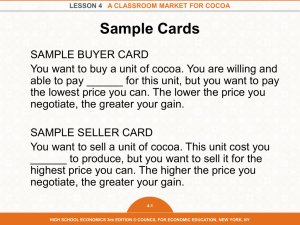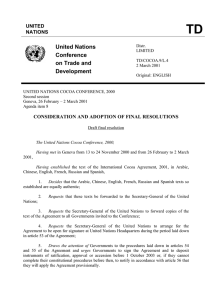Cocoa Market Update - World Cocoa Foundation
advertisement
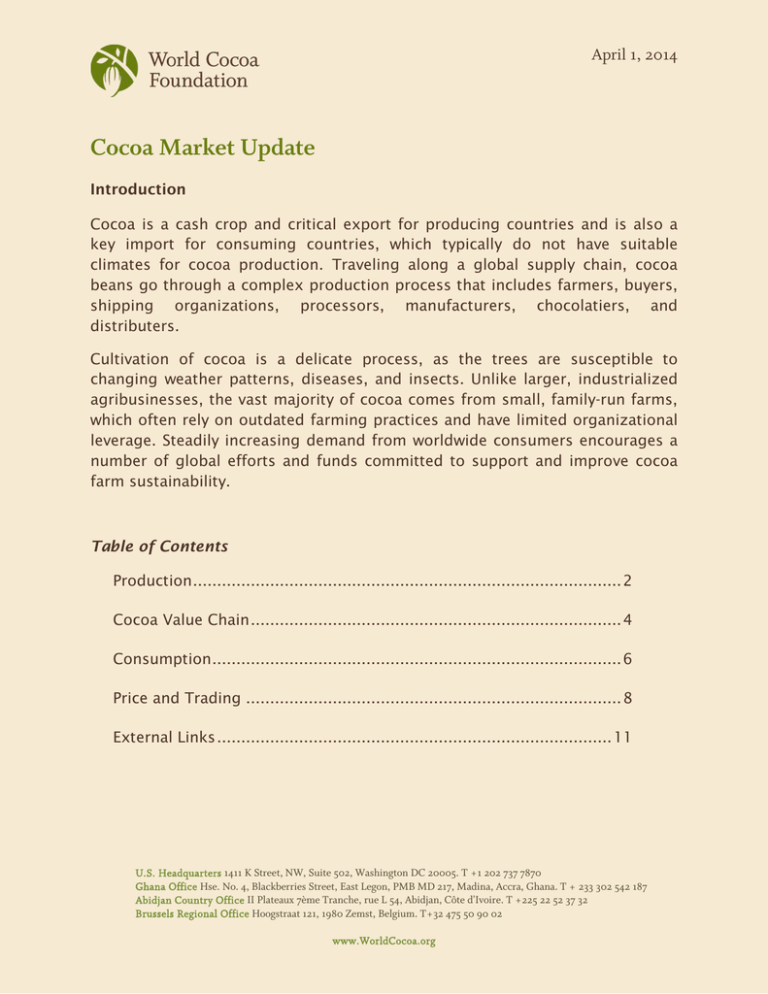
April 1, 2014 Cocoa Market Update Introduction Cocoa is a cash crop and critical export for producing countries and is also a key import for consuming countries, which typically do not have suitable climates for cocoa production. Traveling along a global supply chain, cocoa beans go through a complex production process that includes farmers, buyers, shipping organizations, processors, manufacturers, chocolatiers, and distributers. Cultivation of cocoa is a delicate process, as the trees are susceptible to changing weather patterns, diseases, and insects. Unlike larger, industrialized agribusinesses, the vast majority of cocoa comes from small, family-run farms, which often rely on outdated farming practices and have limited organizational leverage. Steadily increasing demand from worldwide consumers encourages a number of global efforts and funds committed to support and improve cocoa farm sustainability. Table of Contents Production ......................................................................................... 2 Cocoa Value Chain ............................................................................. 4 Consumption ..................................................................................... 6 Price and Trading .............................................................................. 8 External Links .................................................................................. 11 U.S. Headquarters 1411 K Street, NW, Suite 502, Washington DC 20005. T +1 202 737 7870 Ghana Office Hse. No. 4, Blackberries Street, East Legon, PMB MD 217, Madina, Accra, Ghana. T + 233 302 542 187 Abidjan Country Office II Plateaux 7ème Tranche, rue L 54, Abidjan, Côte d'Ivoire. T +225 22 52 37 32 Brussels Regional Office Hoogstraat 121, 1980 Zemst, Belgium. T+32 475 50 90 02 www.WorldCocoa.org Production Cocoa trees grow in tropical environments, within 15 to 20 degrees latitude from the equator. The ideal climate for growing cocoa is hot, rainy, and tropical, with lush vegetation to provide shade for the cocoa trees. The primary growing regions are Africa, Asia, and Latin America. The largest producing country by volume is Côte d’Ivoire, which produces 33% of global supply. Global Cocoa Production Major producing countries in each region include: • Africa Côte d’Ivoire, Ghana, Nigeria, Cameroon • Asia/Oceania Indonesia, Malaysia, Papua New Guinea • Americas Brazil, Ecuador, Colombia Asia 17% Americas 15% Africa 68% Unlike large, industrialized crops, 80% to 90% of cocoa comes from small, family-run farms, with approximately five to six million cocoa farmers worldwide. In Africa and Asia, the typical farm covers two to four hectares (five to ten acres). Each hectare produces 300 to 400 kilograms of cocoa beans in Africa and about 500 kilograms in Asia. Cocoa farms in the Americas tend to be slightly larger and produce 500 to 600 kilograms of cocoa beans per hectare. Yield per hectare varies not only by region, but also by country and by type of cocoa. Trade balances, pricing, and futures contracts depend on accurate supply estimates, so cocoa production is monitored throughout the supply chain, as well as by governments and international organizations. 2 As shown below, total production has increased by 13%, from 4.3 million metric tons in 2008 to 4.8 million metric tons in 2012. This represents an average year-over-year production increase of 3.1%. Thousands Global Cocoa Production (metric tons) 5,300 5,100 4,900 4,700 4,500 4,300 4,100 3,900 3,700 3,500 2008 2009 2010 2011 2012 This rate of increase may slow in the coming years, as cocoa trees are sensitive to changing weather patterns. Periods of drought and of excessive rain or wind can negatively impact yield, and will continue to fluctuate as climate change intensifies. 3 Cocoa Value Chain Growing: Cocoa trees grow on small farms in tropical environments, within 15-20 degrees of latitude from the equator. Cocoa is a delicate and sensitive crop, and farmers must protect trees from wind, sun, pests, and disease. With proper care, cocoa trees begin to yield pods at peak production levels by the fifth year, and they can continue at this level for ten years. Harvesting: Ripe pods may be found throughout the continuous growing season; however, most countries have two peak production harvests per year. Changes in weather patterns can dramatically affect harvest times and yields, causing fluctuations from year to year. Farmers remove pods from the trees using long-handled steel tools. Pods are collected and split open with a sturdy stick or machete, and the beans inside are removed. A farmer can expect 20 to 50 beans per pod, depending on the variety of cocoa. Approximately 400 beans are required to make one pound of chocolate. Fermenting and Drying: Farmers pack the fresh beans into boxes or heap them into piles covered with mats or banana leaves. The layer of pulp that naturally surrounds the beans heats up and ferments the beans. Fermentation lasts three to seven days, and it is the critical step that produces the familiar chocolate flavor. The beans then dry for several days in the sun or under solar dryers. Marketing: After the dried beans are packed into sacks, the farmer sells them to a buying station or local agent, who transports the bags to an exporting company. The exporter inspects the cocoa and transports it to a warehouse near a port. Packing and Transporting: The exporter ships the beans to the processing location, where the cocoa is moved to a pier warehouse until needed. Details of export process vary by country. The buyer conducts a quality check to accept delivery and the cocoa is stored until requested by the processor or manufacturer. Trucks or trains carry the cocoa in large tote bags or loose in the trailer to the manufacturer’s facility, on a “just-in-time” basis. 4 Roasting and Grinding: Before processing, the beans are thoroughly inspected and cleaned. The inside of the cocoa bean is called the nib. Depending on the manufacturer’s preferences, beans can be roasted whole, or the nib can be roasted alone. Once the beans have been shelled and roasted (or roasted and shelled), the nib is ground into a paste. The heat generated by this process causes the cocoa butter in the nib to melt, creating “cocoa liquor.” Cocoa liquor does not contain alcohol and is solid at room temperature. It can be further refined, sold as unsweetened baking chocolate, or used in chocolate manufacturing. Pressing: The cocoa liquor is fed into hydraulic presses that divide liquor into cocoa butter and cocoa cakes. The cocoa cake can be sold into the generic cocoa cake market, or ground into a fine powder. The processor may pre-treat the cocoa liquor with an alkali solution (alkalizing), which reduces acidity. This treatment is known as “dutching” and produces Dutch processed cocoa when pressed. Alkalized liquor becomes darker, develops a more robust chocolate flavor, and stays in suspension longer in liquids such as milk. Chocolate Making: To make chocolate, cocoa liquor is mixed with cocoa butter, sugar, and sometimes milk. The mixture is poured into conches—large agitators that stir and smooth the mixture under heat. Generally, the longer chocolate is conched, the smoother it will be. Conching can last from a few hours to three full days. After conching, the liquid chocolate may be shipped in tanks or tempered and poured into block molds for sale to confectioners, dairies, or bakers. Consumer: Today, people around the world enjoy chocolate in thousands of different forms, consuming more than 3 million tons of cocoa beans annually. Each country and region has unique preferences and distinctive blends for candy and desserts. The cocoa, chocolate, and confectionery industry employs hundreds of thousands of people around the world and is a key user of other agricultural commodities such as sugar, dairy, nuts, and fruits. 5 Consumption Once cocoa beans have been harvested, fermented, dried, and transported, they are processed into separate components for commercial consumption. Processor grindings of cocoa beans serve as the key metric for market analysts, for an overall view of historical and anticipated demand. Processing is the last phase in which demand for cocoa beans can be equitably compared to supply— after this step, the individual components of the bean are sold across many industries to manufacture confections, soaps, and cosmetic items. Global market share for processing has remained stable, even as grindings increase to meet demand. The Netherlands is the largest processing country by volume, handling about 13% of global grindings. Though unsuitable for growing cocoa, Europe as a whole comprises nearly 40% of the processing market. The remaining 60% is divided almost evenly between Africa, Asia, and the Americas. Thousands Market Share: Global Cocoa Grindings 4,500.00 4,000.00 3,500.00 3,000.00 Africa 2,500.00 Asia 2,000.00 Americas 1,500.00 Europe 1,000.00 500.00 2008 2009 2010 2011 2012 Average year-over-year demand growth has been just over 3% since 2008. One of the primary drivers of this increase is the growing middle class in China, India, and Brazil. While Europe and North America are relatively mature 6 markets, increasing discretionary household income in developing countries are a major factor in stable demand growth. As demand is projected to continue its stable growth, supply growth may slow due to changing weather patterns in the largest cocoa-producing areas. This combination of changes in supply and demand may put upward pressure on cocoa and chocolate prices, depending on how quickly these changes occur. Post-Processing Demand Demand for post-processing cocoa products (butter, powder, cake, and paste) is also tracked, but it is measured in nominal dollar value of imports, rather than volume of cocoa beans consumed. 2011 Imports (Nominal value in $1000s) Cocoa Butter Germany United States Netherlands Belgium France United Kingdom Switzerland Russia Poland Canada 464,280 453,387 414,183 363,818 276,581 185,013 151,780 149,458 135,290 119,536 Cocoa Powder & Cake United States Spain France Germany Netherlands Italy Russia Malaysia China, mainland Australia 781,154 271,419 265,065 258,995 239,136 141,405 140,682 136,801 121,255 118,866 Cocoa Paste Germany France Netherlands Belgium Russian Poland United States Ukraine China, mainland Canada 356,263 351,436 350,070 220,884 167,643 141,226 105,641 94,230 90,448 84,605 As the primary regions for chocolate manufacturing, Europe and the United States are the main importers of post-processing cocoa products. However, from 2008 to 2011, China grew from the 12th to 9th largest importer of cocoa paste and from the 15th to 9th largest importer of cocoa powder and cake. This dramatic increase is likely due to rising local demand for chocolate and chocolate-flavored products. 7 Price and Trading Cocoa beans trade on two world exchanges: London (NYSE LIFFE - GBP) and New York (ICE - USD). Cocoa futures contracts are the benchmark global price quote for cocoa. Each contract is 10 metric tons, and prices are quoted in U.S. dollars per metric ton. Contracts are traded for delivery of cocoa beans in March, May, July, September, and December and are considered settled upon receipt of the beans. The ICCO Daily Price is the average daily closing price of the three nearest delivery date contracts trading on that day. The ICCO Daily Price first closed above $3,000 per metric ton on February 12, 2014. Cocoa futures prices have increased by 37% in the last year, from about $2,211 per metric ton in late March 2013, and have increased about 13% in the last six months. ICCO daily price (USD/metric ton) $3,200 $3,100 $3,000 $2,900 $2,800 $2,700 $2,600 $2,500 $2,400 1-Oct-13 1-Nov-13 1-Dec-13 1-Jan-14 1-Feb-14 1-Mar-14 The rate of price change charts below compare volatility in cocoa prices to volatility of other commodity prices over the last five years. Historically, cocoa prices have been less prone to severe price fluctuations than large scale grains, 8 like wheat and corn. This may be due to the difference in scale of global production and consumption, as well as differing degrees of speculative investment, which may exacerbate volatility in commodity prices. Wheat Relative to palm oil and rubber, cocoa prices have been slightly more stable. In cocoa-producing regions, palm oil and rubber are increasingly competitive alternatives for farmers, so relative price stability is an important metric. Palm Oil 9 Rubber Coffee prices are somewhat more stable than rubber and palm oil prices. Before increasing in volatility over the last 12 months, coffee had similar price stability to cocoa. Coffee 10 External Links For more information on the cocoa market, please refer to the resources listed below or visit www.worldcocoa.org. Cocoa Prices Bloomberg Agricultural Commodity Prices http://www.bloomberg.com/markets/commodities/futures/agriculture/ Intercontinental Exchange (ICE) Cocoa Brochure https://www.theice.com/publicdocs/ICE_Cocoa_Brochure.pdf NYSE Euronext Global Derivatives: Cocoa Futures https://globalderivatives.nyx.com/en/products/commodities-futures/CDLON/contract-specification The International Cocoa Organization (ICCO) Daily Prices http://www.icco.org/statistics/cocoa-prices/daily-prices.html Cocoa Trade Statistics Food and Agriculture Organization of the United Nations (FAOSTAT) http://faostat3.fao.org/faostat-gateway/go/to/download/Q/QC/E The International Cocoa Organization (ICCO) Production, Grindings, Supply & Demand Statistics http://www.icco.org/statistics/production-and-grindings/production.html 11
